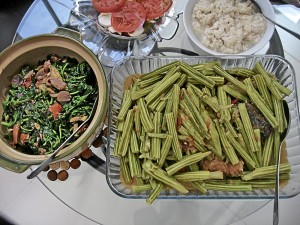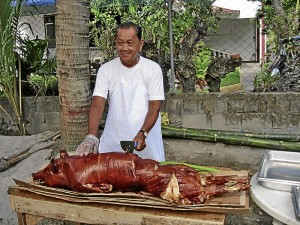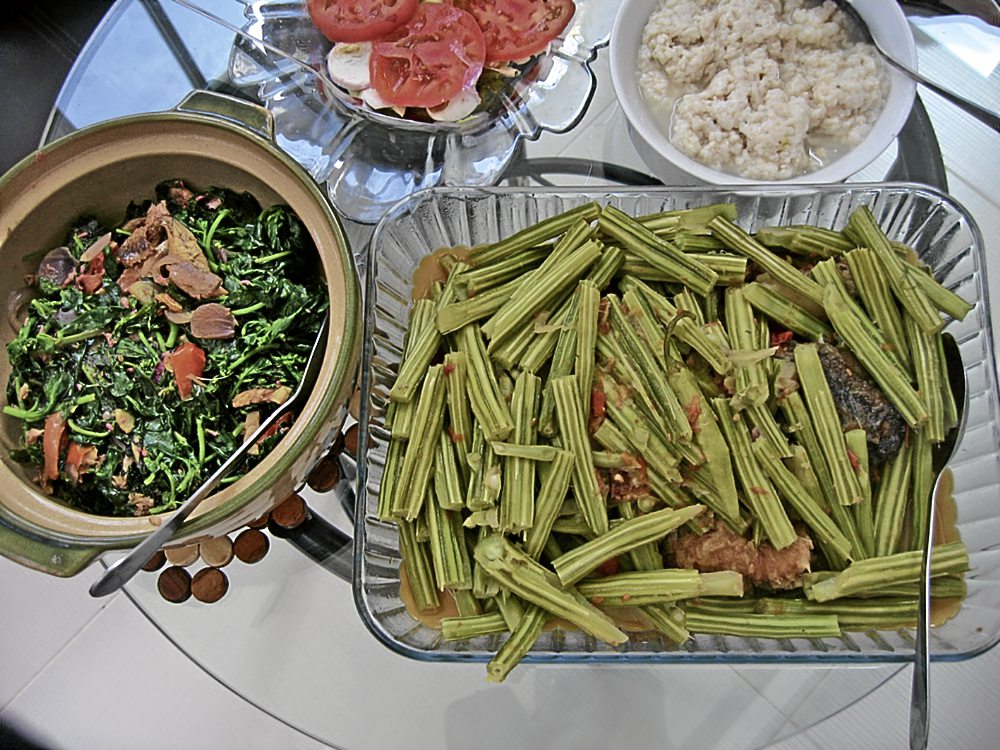
For many, Paniqui, Tarlac, is not the final destination, but a mere passageway to other places. When I see the name on the welcome arch along the highway, it always makes me wonder about this place, but we never stop to explore.
Paniqui (paniki) means bat, the nocturnal mammal that someone told me lived in the numerous caves and fed on the fruit orchards of Tarlac. Are the bats still there?
Good timing
So, when we were invited to visit Paniqui and get a chance to taste the cooking there, curiosity got us going. The timing couldn’t have been better, because there was a food festival that evening called Sida Sida. The name is Ilocano for ulam (viand) and the repetition indicates there would be a lot of it.
The festival site was at the town plaza called Auditorium. Several long tables were set up with food, along with round tables for the diners. Tickets were sold to the people of the town and the many balikbayan who wanted to partake of the feast and celebrate the cooking of the province.
Our geography lessons in school said that the people of Tarlac are a mix of Ilocano, Pampango, Pangasinense and Tagalog, from the provinces that surround this landlocked place. We were also taught that “melting pot” was the moniker for Tarlac. But that also aptly describes the cuisine, because each group has contributed to what is now regarded as Tarlac cooking. And while the provenance of the dishes may come from the different linguistic groups, Tarlaqueños consider the cuisine as their own.
Some of the food served at Sida Sida we saw cooked earlier in the yard of Dr. Mona Rayos, who took charge of all the dishes. Several vats were on the ground, boiling with oil as catfish was being fried.
We were also shown what had been done even earlier. There was papaitan that was dry, not the soupy kind I’m used to, almost like bopis. It’s called bagis kambing, more Pampango rather than Ilocano. There was pakbet, which hewed to the Pampango version with squash, and kaldereta in huge pots, a tamer version of the rich Pampanga stew with olives and cheese.
Just-delivered rice cakes made its way to the table, a biko or bibingkang malagkit and an ube kakanin that you could tell was made from pure purple yam. The most tempting was lechon that had just been roasted elsewhere, with the man-in-charge ready to chop those to fit into chaffing dishes.
We had a taste of all that, the lechon taking a lot of our attention because it was done to perfection. And to think we were full from a heavy lunch.
Civic-minded folk
The lunch was prepared by civic-minded people who want to put Paniqui on the culinary map. And for this, nothing convinces better than tables laden with home-cooked dishes and served at the residence of Bong Fernandez. He led us to a big black clay pot of kinulob, usually cooked for Christmas in his family. It was a meat medley of whole native chicken, ham hock, chorizo Bilbao, isaw (chicken or pork intestines), and pork liempo (belly), all braised slowly with carrots, cabbage and potato. Puchero came to mind, the boiled meat dish.
Fernandez pointed out some sautéed vegetables that are rarely or not even seen in Manila markets—malunggay pods that his wife, Karen, cooked with pork liempo, and papaet leaves, which are bitter indeed and which he also cooked.
Dr. Concepcion Llamas made her festive dish of pastel de pollo, which places the pastel ingredients as stuffing for the chicken—quite a creative and different way. Her lumpiang buko can replace that of ubod anytime. She also brought out binuburan, fermented rice that I thought was only to be found in the Cordilleras. It is what farmers eat first thing in the morning before setting out because it warms the stomach.
In Paniqui, only Lucerna Palarca makes it, and she is 83 years old, according to our guide Rene Guatlo. Who will then take over?
The table groaned with more food—crispy ukoy made with small shrimps; mudfish (dalag) served with balaw-balaw (fermented rice) and steamed vegetables; shrimp paste (bagoong alamang) to flavor chopped tomatoes, onions, mango and a seaweed that resembled hair strands. And there was Tarlac’s boboto, which is how tamales, a rice concoction flavored with peanuts, is called there.
Our hosts talked about what we were not having, a sneaky way of telling us there was more than the variety we were having. There is the candied singkamas, which is uniquely Paniqui, and guinataan aguro or cone-shaped shells (suso) that requires one to be a good kisser to suck out the meat at the wide end.
Suggestions

We only stayed at the beginning of Sida-Sida since we had eaten far too much already and had sampled what was to be served that evening. But we were ready with suggestions to Mayor Miguel Revilla on how to make Paniqui an eating destination.
Why not invite tour groups to experience Sida-Sida, develop it the way the Duman Festival in Sta. Rita, Pampanga, has become a must-experience for foodies? Why not help create roadside restaurants to invite travelers to stop and taste Paniqui cooking—without the surreal look of another town’s restaurant with the ungrammatical claim that it is “the halfway to the north”?
A billboard can extend the invitation, but make sure the dish looks inviting. Why not have a stopover station selling Paniqui specialties, such as the candied singkamas of Nanay Mercing; the sardines and chili sauce of Jessie and Dina Cruz; the kesong puti made from carabao and goat’s milk by Dr. Llamas; and the boboto of Digna Sioco Go? Or, develop someone like the Tayags in Angeles, Pampanga, who will cook for you at their home.
E-mail [email protected]














































